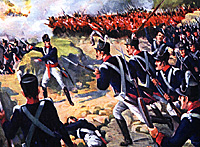This article has been divided into smaller sections for ease of retrieval--RL
HISTORICAL BACKGROUND
The most practical invasion route into Portugal ran through Ciudad Rodrigo and Almeida on the
Spanish-Portuguese border, along the valley of the Mondego to Coimbra, and then to Lisbon.
However, this road contracted into a difficult defile at the Ponte da Murcella over the River Alva and it was at this point that Wellington planned to fight the invaders. He ordered a line of earthwork redoubts to be built on the southern bank of the river and armed it with artillery.
After capturing the two frontier fortresses, Massena marched into Portugal, and Wellington
withdrew as the French advanced. But Massena had learnt of Wellington's defences on the Alva
and instead of taking the main highway to Lisbon Massena led l'armee de Portugal along an
alternative route. Although this new route avoided the Ponte da Murcella the road ran over the steep and dominating ridge of the Serra de Busaco and it was here that Wellington decided to make his stand.
The Battlefield Related
This article appears in MagWeb (Magazine Web) on the Internet World Wide Web. In the days before accurate large-scale maps and aerial reconnaissance, the commander had to have an eye for ground. The disposition of defending troops and the deployment and direction of attacking forces were almost invariably influenced by the local geography. In this, the first of a number of articles on battlefield topography, I hope to show the reader, through the "eye" of the camera, of the advantages and handicaps that the terrain presented to military command.
In the days before accurate large-scale maps and aerial reconnaissance, the commander had to have an eye for ground. The disposition of defending troops and the deployment and direction of attacking forces were almost invariably influenced by the local geography. In this, the first of a number of articles on battlefield topography, I hope to show the reader, through the "eye" of the camera, of the advantages and handicaps that the terrain presented to military command.
 On 17 April 1810, Napoleon announced the formation of "L'armee de Portugal". It was to be
composed of three army corps plus reserve cavalry and artillery divisions, with a total effective force of approximately 82,000 men. Placed under the command of Marshal Andre Massena, its objective was to reconquer Portugal and drive out of the country Wellington's small British army which had been assisting the Portuguese in their struggle for independence.
On 17 April 1810, Napoleon announced the formation of "L'armee de Portugal". It was to be
composed of three army corps plus reserve cavalry and artillery divisions, with a total effective force of approximately 82,000 men. Placed under the command of Marshal Andre Massena, its objective was to reconquer Portugal and drive out of the country Wellington's small British army which had been assisting the Portuguese in their struggle for independence.
The Defenders (and OOB)
The Attackers (and OOB)
The Battle
Back to Battlefields Vol. 1 Issue 4 Table of Contents
© Copyright 1996 by Partizan Press.
Other military history articles and gaming articles are available at http://www.magweb.com